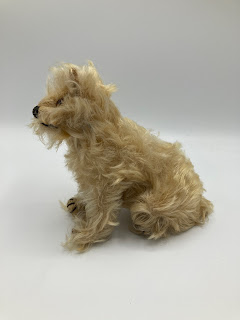And they call it puppy love! And for good reason. This sweet sitting pup recently joined Steiffgal's hug. He came in a giant box lot. But as all collectors know... sometimes these types of purchases contain unexpected treasures like this.
Sit and stay and check out this sweet pup. He is a sweet example of Steiff's Pinscher dog. He is 17 cm tall, sitting, and unjointed. He is made from long tan mohair that was tipped in brown when he was new. You can see this tipping in his armpits, folds, and other places where the sun does not shine! Pinscher has black hand embroidered claws on his front and back paws. His face is detailed with charming proportional brown and black glass pupil eyes, a black hand stitched nose and mouth, a spot of red on his lips, and a center-seamed muzzle. His pert triangular mohair ears are lined in tan felt, and as is customary to the breed, he has a proportionally very small tail. He has a nonworking squeaker in his belly.
Sit and stay and check out this sweet pup. He is a sweet example of Steiff's Pinscher dog. He is 17 cm tall, sitting, and unjointed. He is made from long tan mohair that was tipped in brown when he was new. You can see this tipping in his armpits, folds, and other places where the sun does not shine! Pinscher has black hand embroidered claws on his front and back paws. His face is detailed with charming proportional brown and black glass pupil eyes, a black hand stitched nose and mouth, a spot of red on his lips, and a center-seamed muzzle. His pert triangular mohair ears are lined in tan felt, and as is customary to the breed, he has a proportionally very small tail. He has a nonworking squeaker in his belly.
Like most of Steiff's creations, this Pinscher is lovingly and authentically rendered. He in a very appealing and authentic sitting position; his back legs are angled and bent in the way a real puppy sits - especially when they are trying coax you into giving them a snack! This guy retains his long trailing "f" Steiff button and bits of his red tag as his Steiff IDs. This tipped mohair Steiff Pinscher pattern was produced in 17, 22, 28, 35, 43, and 50 cm from 1914 though 1931 overall.
Pinschers are few and far between in the Steiff line. Over time, three versions were produced prewar. As far as Steiffgal can tell, there has not been one in the line after the early 1940s. It is interesting to note that Steiff's debut Pinscher was produced at the same time as the company's rod jointed bears. Like the rod jointed bears, this guy was also fully rod jointed, had black wooden shoebutton eyes, and a handmade black gutta percha nose. He appeared in 35 cm from 1903 through 1906. He had a distinctly Teddy bear look to him but his limbs were more slender and he did not have felt paw pads. You can see a picture of him here on the left; the image is from Pfeiffer's 1892-1943 Sortiment.
Pinschers are few and far between in the Steiff line. Over time, three versions were produced prewar. As far as Steiffgal can tell, there has not been one in the line after the early 1940s. It is interesting to note that Steiff's debut Pinscher was produced at the same time as the company's rod jointed bears. Like the rod jointed bears, this guy was also fully rod jointed, had black wooden shoebutton eyes, and a handmade black gutta percha nose. He appeared in 35 cm from 1903 through 1906. He had a distinctly Teddy bear look to him but his limbs were more slender and he did not have felt paw pads. You can see a picture of him here on the left; the image is from Pfeiffer's 1892-1943 Sortiment.
After an eight year hiatus, Pinschers again graced the Steiff catalog. The Pinscher under discussion here today followed the rod jointed version. Steiff's final Pinscher was similar to the tipped version, but made in long grey brown mohair in 17, 22, and 28 cm from 1935-1942.
Pinschers are a distinctly German breed, so it should be no surprise that Steiff chose to produce a few for their line. These dogs originated in southern Germany (also where the Steiff company is located.) They were first officially recognized in 1885 and accepted into the American Kennel Club in 2003. German Pinschers were one of the foundation breeds in the origins of the Doberman Pinscher and the Miniature Pinscher as we know them today. German Pinschers were almost lost to time both post WWI and WWII. According to the AKC, there were no litters registered in West Germany from 1949 to 1958. Due to the heroic efforts of one man, the breed was rescued via intensive breeding and conservation efforts.
Steiffgal hopes this discussion on this petite Pinscher has brought a little more happiness to your day.
Have a question about one of your Steiff treasures? Let's talk! Click here to learn more.
Have a question about one of your Steiff treasures? Let's talk! Click here to learn more.

















